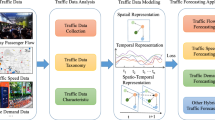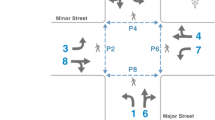Abstract
The objective of this work is to develop a novel feature for traffic flow models, when traffic queues on two-way arterials periodically extend until then they block an upstream signal in oversaturated conditions. The new model, proposed as conditional cell transmission model (CCTM) has been developed with two improvements. First, cell transmission model (CTM) is expanded for two-way arterials by taking account of all diverging and merging activities at intersections. Second, a conditional cell is added to simulate periodic spillback and blockages at an intersection. The results of experiments for a multilane, two-way, three-signal sample network demonstrate that CCTM can accommodate various traffic demands and accurate representation of blockages at intersections. The delay of left turns is underestimated by 40 % in moderate conditions and by 58% in oversaturated condition when using the CTM rather than CCTM. Finally, the consistency between HCS 2000 and CCTM shows that CCTM is a reliable methodology of modeling traffic flow in oversaturated condition.
Similar content being viewed by others
References
NIU Wen-yuan. Fifteen large cities lose nearly one billion RMB per day due to traffic congestion [ER/OL]. http://bkb.ynet.com/article.jsp?oid=72370228.
PIGNATARO L J, MCSHANE W R, CROWLEY K W, LEE B, CASEY T W. Traffic control in oversaturated street networks [R]. Washington D C: Transportation Research Record, National Research Council, 1978.
TANG Tie-qiao, LI Chuan-yao, HUANG Hai-jun, SHANG Hua-yan. Macro modeling and analysis of traffic flow with road width [J]. Journal of Central South University of Technology: 2011, 18(5): 1757–1764.
LIU Tian-liang, HUANG Hai-jun, TIAN Li-jun. Microscopic simulation of multi-lane traffic under dynamic tolling and information feedback [J]. Journal of Central South University of Technology: 2009, 16(5): 865–870.
YIN Y F, LIU H X, LAVAL J A, LU Xiao-Yun, LI Meng, PILACHOWSKI J, ZHANG Wei-Bin. Development of an integrated microscopic traffic simulation and signal timing optimization tool [D]. Berkeley: University of California, 2007.
GURUPACKIAM S, JONES L S, FONSECA J D. Investigating initialization times, repetitions, and MOE variability in simulation of under saturated and saturated traffic signals [C]// 6th International Symposium on Highway Capacity and Quality of Service Social and Behavioral Sciences, Stockholm, 2011: 1–2.
LIGHT M J, WHITHAM B. On kinematic waves. I: Flow movement in long rivers; II: A theory of traffic flow on long crowed roads [C]// Proceedings of Royal Society of London (Series A). London: The Royal Society, 1955: 281–345.
RICHARDS P I. Shockwaves on the highway [J]. Operation Research, 1956, 4(1): 42–51.
SHI Feng, ZHOU Wen-liang, LIU Fen-fang, DENG Lian-bo. Two-lane roundabout traffic flow characteristics based on cellular automaton [J]. Journal of Central South University: Science and Technology, 2010, 41(4): 1616–1622. (in Chinese)
CHEN Qian, WANG Wei, Application of fuzzy optimization method based on CTM for traffic trunk line control under special events [J]. Journal of Southeast University, 2008, 138(5): 861–865. (in Chinese)
LO H K. A novel traffic signal control formulation [J]. Transportation Research Part A, 1999, 33(6): 433–448.
LO H K. A cell based traffic control formulation: strategies and benefits of dynamic timing plans [J]. Transportation Science, 2001, 35(2): 148–164.
WENG Ping. Conditional cell transmission model for two way arterials in oversaturated conditions [D]. USA: University of Alabama, 2010.
LO H K, CHOW A H F. Control strategies for oversaturated traffic [J]. Journal of Transportation Engineering, 2004, 130(4): 462–477.
LI Z, CHANG G L. Modeling arterials signal optimization with enhanced cell transportation formulations [C]// Transportation Research Board 89th Annual Meeting. Washington D C: National Research Council, 2010: 1–2.
LIN W H, AHANOTU D. Validating the basic cell transmission model on a single freeway Link [D]. Berkeley: University of California, 1995.
SMILOWITZ K R, DAGANZO C F. prediction of time dependant traffic backups and other reproducible traits in experimental highway data [D]. Berkeley: University of California, 1999.
ROESS R P, PRASSAS E S, MCSHANE W R. Traffic engineering. third edition [M]. New Jersey: Prentice Hall, 2004: 650.
U.S. Department of Transportation. Manual on uniform traffic control devices [M]. Washington D C: Federal Highway Administration, 2009: 66800.
U.S. Department of Transportation. Traffic analysis toolbox volume III: Guidelines for applying traffic microsimulation modeling software [M]. Washington D C: Federal Highway Administration, 2004: 85.
ABU-LEBDEH G, BENEKPOHAL R. Development of a traffic control and queue management procedure for oversaturated arterial [C]// Transportation Research Board Annual Meeting. Washington D C: National Research Council, 1997: 119–126.
Author information
Authors and Affiliations
Corresponding author
Additional information
Foundation item: Project(51108343) supported by the National Natural Science Foundation of China; Project(06121) supported by University of Transportation Center for Alabama, USA
Rights and permissions
About this article
Cite this article
Wang, P., Jones, L.S. & Yang, Q. A novel conditional cell transmission model for oversaturated arterials. J. Cent. South Univ. Technol. 19, 1466–1474 (2012). https://doi.org/10.1007/s11771-012-1163-6
Received:
Accepted:
Published:
Issue Date:
DOI: https://doi.org/10.1007/s11771-012-1163-6




